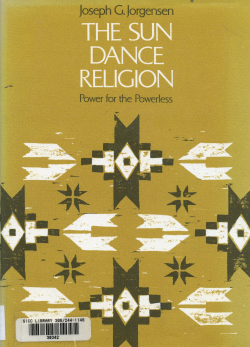The sun dance religion : power for the powerless

Type
Book
Authors
Joseph G. Jorgensen ( Jorgensen, Joseph G. )
ISBN 10
0226410854
ISBN 13
9780226410852
Category
General Library Collection
[ Browse Items ]
Publication Year
1972
Publisher
Pages
360
Subject
Sun dance
Tags
Description
"The American Indian has sought every possible recourse from his oppression by white society; he has submitted, bargained, fled, and fought. None of his attempts has brought any power to his powerless people. He has thus organized social movements within his own community from which he may obtain feelings of power. The most successful of these movements has been the Sun dance religion of the Rocky Mountain area Utes and Shoshones.
Joseph Jogenson provides a political and economic analysis of how and why the Sun dance came to be, tracing its historic development as a response to Indian deprivation at the hands of whites. Altered from an early nineteenth century version by the Wind River Shoshones of Wyoming, the dance rapidly spread to their congeners in Utah, Colorado, and Idaho. Professor Jorgenson delineates the contexts in which the religion has persisted since early reservation days (circa 1880-1890). He also describes the nature of the modern dance: the ritual, the religious experience, the role of chiefs, the recruitment of novice dancers, and the participation of nondancers. Finally, he presents a comparative analysis of the Sun dance community, an interreservation phenomenon.
The Sun dance ceremony, taking place several times each year, is a three-day, three-night ordeal of dancing and fasting designed to bring redemption and spiritual power to the participants. The whole community, including visitors, is drawn into the ceremony - as singers, aids to the dancers, or observers. More realistic than the earlier Ghost dance religion, which promised a new society dominated by Indians, the Sun dance provides for power and redemption amidst the deprivations of the present society.
Professor Jorgenson grew up close to the Utes, and has spent his life studying their activities and those of the Shoshones. He early recognized the Sun dance as the most significant cultural movement of both tribes. This study, in addition to its importance for the sciences of sociology and anthropology, contributes valuable information for the growing general societal concern with the American Indian's life of extreme hardship and deprivation. It also explains just how the Sun dance helps the Utes and Shoshones to endure that deprivation. The author does not foresee the death of the dance, or even its transformation in the near future into an establishment religion. As long as oppression continues, so will the Sun dance." -- Book jacket.
Joseph Jogenson provides a political and economic analysis of how and why the Sun dance came to be, tracing its historic development as a response to Indian deprivation at the hands of whites. Altered from an early nineteenth century version by the Wind River Shoshones of Wyoming, the dance rapidly spread to their congeners in Utah, Colorado, and Idaho. Professor Jorgenson delineates the contexts in which the religion has persisted since early reservation days (circa 1880-1890). He also describes the nature of the modern dance: the ritual, the religious experience, the role of chiefs, the recruitment of novice dancers, and the participation of nondancers. Finally, he presents a comparative analysis of the Sun dance community, an interreservation phenomenon.
The Sun dance ceremony, taking place several times each year, is a three-day, three-night ordeal of dancing and fasting designed to bring redemption and spiritual power to the participants. The whole community, including visitors, is drawn into the ceremony - as singers, aids to the dancers, or observers. More realistic than the earlier Ghost dance religion, which promised a new society dominated by Indians, the Sun dance provides for power and redemption amidst the deprivations of the present society.
Professor Jorgenson grew up close to the Utes, and has spent his life studying their activities and those of the Shoshones. He early recognized the Sun dance as the most significant cultural movement of both tribes. This study, in addition to its importance for the sciences of sociology and anthropology, contributes valuable information for the growing general societal concern with the American Indian's life of extreme hardship and deprivation. It also explains just how the Sun dance helps the Utes and Shoshones to endure that deprivation. The author does not foresee the death of the dance, or even its transformation in the near future into an establishment religion. As long as oppression continues, so will the Sun dance." -- Book jacket.
Number of Copies
2
| Library | Accession No | Call No | Copy No | Edition | Location | Availability |
|---|---|---|---|---|---|---|
| Main | 30342 | E99.U8 J67 | 1 | Yes | ||
| Main | 14440 | E99.U8 J67 | 2 | Yes |